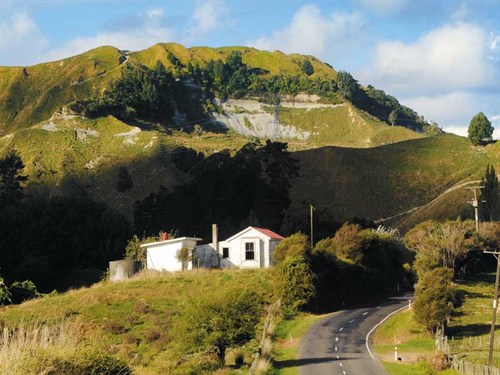
Taumarunui and Stratford mark either end of SH43, 150 kilometres of backcountry road, known as the Forgotten World Highway that twists and turns through valleys and up razor ridges.
Leaving Taumarunui, heading west, the road follows a valley carved over millions of years by the Whanganui River. The river makes this part of the journey memorable. It’s young here, dashing over stones, always in a hurry. There are riverside places where free-camping is still OK and where people fish for trout, and swim in deep clear pools.
As we follow the river it grows, gaining water and depth until it becomes deep, green, and purposeful. The road and river part company at Aukopae Landing, a straight piece of riverbank that was once the last landing place for steam-driven paddleboats that chugged up from Wanganui bringing settlers, supplies, and livestock. All that remains of their cottages are lone chimneys standing in an explosion of pink naked-ladies. Apple trees, taller than the chimneys, keep on fruiting.
We make a 10-kilometre detour to Ohura, once a thriving coal, mill, and farming town with a population of 3000 but now a ghost of its previous self with 167 people. It’s other big business, Ohura State Prison, a white collar penitentiary with 100 cells, closed in 2007, but was bought by an optimist as a retirement project. It’s now funky accommodation where one can sleep in a comfortable cell, complete with metal door, for just $18 a night.
The shops that edge the wide main street are almost all closed though many have artfully arranged treasure in their windows. Corrugated iron roofs are 20 shades of rust, the wooden facades have peeling paint with printed echoes of past occupants (Firestone, Williams & Kettle) and cowboy-style overhangs keep ghost customers dry on rainy days. All it needs is a tumble weed to roll down the empty street at high noon.
Moki Tunnel is the next big thing on Highway 43. The Moki Hill saddle was a swine in which cars got bogged to their axles, so the Stratford Council built the 180-metre tunnel in 1936 using a steam-driven compressor to power two jackhammers.
From here to Whangamomona, big country gets bigger and even the sheep seem tiny. When we arrive, The Heritage Hotel is basking in sun and groups quietly chat over beer. It’s not long before we join them and relax into the quiet ambience of this 60-people, 12-horse town.
During the night, there’s rain on the corrugated iron roof and by morning Whangamomona is shiny and dripping. As we leave, the road dives straight into bush. It’s breathing, exhaling mist that swirls and changes shape. I revel in absolute green – fern fronds with dripping points, skeins of hanging moss woven with thousands of diamond drops, and giant trees that thrust their crowns above the others.
The Whangamomona, Pohokura, and Strathmore Saddles are a breeze to cross now, on a sealed road, but a century ago it took five days for pack horses to bring supplies to settlers. They are still a barrier, marking the division between rolling, fecund, and tidy Taranaki and the expansive, steep, and scraggy sheep country we have driven through.
Stratford, at the Taranaki end of Highway 43, in the heart of dairy country, is busy and bustling. Big milk payouts bring prosperity and fancy cars, and rosy-cheeked women with generous dairy-product bottoms fill carts at supermarkets, browse the racks at frock shops, and meet for ladies’ lunches.
If Taumarunui was in dairy country instead of sheep country it, too, might be like this. Such is the fate of farming.
State Highway 43 is a journey that tells of dust and rust and days past, as it curls through an elemental landscape, forested and misty, or stripped bare with just a skin of grass, patterned with daisy-white dots of distant sheep.






